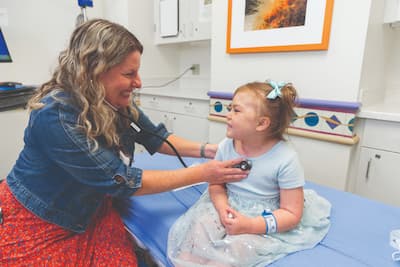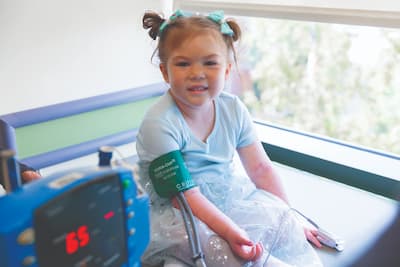Ganglioglioma: new drugs provide solutions and challenges - Mayia's Story
Meet Mayia

Mayia is an outgoing 6-year-old who loves being outside, going on walks and hanging out with her older twin brothers. If you take her to a dollar store, she’ll skip the toy aisle for other entertainments — a cake mix to bake with her mom, soap to make bubbles, or markers and stickers for creative projects.
“She knows what she wants when she wants it,” laughed Mayia’s mom, Misti Villegas. “She’s a very happy kid.”
When Mayia was turning 4, her preschool teachers noticed she stopped using her right hand. Mayia is left-handed, but the change in her hand use was different than a preference. She was letting her right arm hang at her side. Her pediatrician thought it was a pulled elbow, but Mayia’s parents and her preschool principal thought something else was wrong.
Misti and Roy, Mayia’s dad, took her to Children’s Mercy, where doctors discovered a tumor with two cysts pushing on the left side of her brain and interrupting her right-side mobility. Four days later, April 29, 2022, Mayia had her first brain surgery.
“They thought the tumor would be soft, and they would be able to scoop most of it out,” Misti said. “But when they went in, it was really hard scar tissue, and they were only able to get a little piece of it to test.”
What they hoped would be a full resection turned out to be only a partial resection and biopsy. The surgeons also inserted an Ommaya reservoir that allows them to periodically drain fluid off the cyst. Trying to do more would have put Mayia at risk.

“The suprasellar region is a very delicate, primitive part of the brain that controls a lot of basal and hormonal functions, so it can be very devastating to try to remove too much of Mayia’s tumor,” explained Kevin Ginn, MD, neuro-oncologist and Director of the Pediatric Brain Tumor Program.
Mayia’s tumor is a metastatic ganglioglioma. “It falls into the low-grade glioma family of tumors, which is the most common type of tumor in pediatrics,” said Dr. Ginn.
“Her tumor had melanocytic differentiation, which was unusual,” added Dr. Ginn, explaining that was more common in skin cancers. The tumor also has a genetic mutation, BRAF V600E, that can be targeted with drugs that inhibit that specific mutation’s growth signal.
Mayia’s care team, including neuro-oncology nurse practitioner Diana Healy, APRN, BC, CPHON, started her on three rounds of the “gold-standard chemotherapy,” a carboplatin-based treatment. But her tumor didn’t respond. Dr. Ginn switched strategies to target the BRAF V600E mutation with two agents, dabrafenib and trametinib.
The only problem was that the oral powder and dispersible tablet versions of those drugs weren’t on the market yet. Dr. Ginn petitioned Novartis to get access to the two agents directly from the drug company through what’s called “compassionate use.”

“I felt comfortable with the agents themselves, because I've used them a lot, but the formulations we needed weren’t available,” explained Dr. Ginn. “Once the drug company approved the petition, we had to petition the FDA. Once they approved, we went through our Institutional Review Board, created a consent form and protocol, and had the family sign it as if they were going on a research trial.”
Unlike her initial rounds of chemotherapy, which were administered at Children’s Mercy, Mayia could take these medicines at home with some simple precautions, such as her parents wearing gloves when they prep and deliver the meds. Mayia’s tumor responded well to the new regimen, but she experienced a side effect: skin toxicity.
“In the beginning, she had a significant rash all over her body that resulted in having to hold and reduce those drugs,” Dr. Ginn said. With some trial and error, her team was able to find a dosage strong enough to treat the tumor while managing the skin side effects with at-home interventions.
“We now use 100% coconut oil on her skin,” said Misti, “and that seems to be stabilizing the rash. We also do a Clorox bath a couple times a week and use a sensitive-skin body wash.”
“It’s a manageable, but not ideal, level of toxicity that has to be balanced with tumor response,” said Dr. Ginn.
In the meantime, the FDA approved the drug formulations, and Mayia’s coordinators helped her family switch from the compassionate use protocol to a traditional prescription.
“When these drugs are provided for compassionate use, they’re free from the drug company,” explained Dr. Ginn. “And then suddenly, we’re having to prescribe the drug. We helped the family figure out some financial resources to pay for them, and we’ve now successfully transitioned to the commercial product.”
Mayia has been on the drug combo for a year now, and, so far, it’s halting her tumor’s growth.
“As this point, we don’t really know what it means to have a pediatric patient on something like this for a prolonged period of time,” said Dr. Ginn, explaining that the effect on growth and development isn’t fully understood. “For Mayia and other patients, we’ve set a goal of two years — the typical time frame these drugs were studied on clinical trials — and then consider stopping and seeing what happens, knowing that we may have to go back on them.”

Ongoing Children’s Oncology Group trials will give Dr. Ginn and other oncologists more information about the efficacy and long-term impacts of these drugs, which will help inform strategic treatment decisions in the future.
Currently, Mayia sees Dr. Ginn monthly for labs and a check-up. She has an MRI to track her tumor’s progress every three months. The Endocrine clinic helps treat hormonal disruptions caused by the tumor’s location, and she also gets her heart and eyes checked quarterly. Now that Mayia is stable and able to get her drugs from a traditional pharmacy, her cancer care appointments will likely taper off to once every three months to coordinate with her MRI.
“Dr. Ginn, Diana and their whole team have been amazing,” said Misti. “They’ve made it very easy on us as parents because they’re just so great.”
Learn more about the state-of-the-art clinical care and translational research being done at Children’s Mercy for pediatric central nervous system tumor patients in our 2022-23 Cancer Care Annual Report.